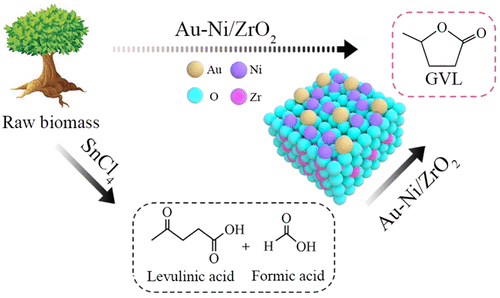当前位置:
X-MOL 学术
›
Ind. Eng. Chem. Res.
›
论文详情
Our official English website, www.x-mol.net, welcomes your
feedback! (Note: you will need to create a separate account there.)
γ-Valerolactone Production from Furfural Residue with Formic Acid as the Sole Hydrogen Resource via an Integrated Strategy on Au-Ni/ZrO2
Industrial & Engineering Chemistry Research ( IF 3.8 ) Pub Date : 2020-04-29 , DOI: 10.1021/acs.iecr.0c01058 Cuiqing Zhou 1 , Yuan Xiao 1 , Shuguang Xu 1 , Jianmei Li 1 , Changwei Hu 1
Industrial & Engineering Chemistry Research ( IF 3.8 ) Pub Date : 2020-04-29 , DOI: 10.1021/acs.iecr.0c01058 Cuiqing Zhou 1 , Yuan Xiao 1 , Shuguang Xu 1 , Jianmei Li 1 , Changwei Hu 1
Affiliation

|
The integrated conversion of raw lignocellulosic biomass selectively to γ-valerolactone (GVL), using formic acid as the sole hydrogen resource, is of great importance from economic and engineering viewpoints. In this work, we developed an integrated strategy for GVL production from furfural residue. Wherein, levulinic acid and formic acid were produced from furfural residue using SnCl4 as a catalyst in the first step, which were subsequently employed as feedstock for GVL production by the catalysis of a developed bimetallic Au-Ni/ZrO2 catalyst in the second step. It was revealed that an appropriate amount of Ni loading could promote the reduction of Auδ+ to Au0, and facilitated Au0 dispersion with less aggregation, when compared to the Au/ZrO2 catalyst. Ni loading also slightly enhanced the amount of Lewis acid on the catalyst. These contributions enabled the high activity of 1Au-2Ni//ZrO2 catalyst with a very small amount of Au loading for the hydrogenation of levulinic acid with formic acid as hydrogen resource, and the subsequent dehydration reaction. 2-Methyltetrahydrofuran extraction before the second step effectively removed the byproducts, possibly polymer/humins, formed simultaneously with levulinic acid, thereby significantly alleviating catalyst poison. With the addition of extra formic acid, overall yields of GVL as high as 51.5 mol % were achieved, based on the total C6 sugar in furfural residue. This work gives a potential strategy for the production of GVL directly from raw lignocellulosic biomass, using formic acid as the sole hydrogen resource.
中文翻译:

基于Au-Ni / ZrO 2集成策略从糠醛残渣中提取甲酸为唯一氢源的γ-戊内酯
从经济和工程的角度来看,利用甲酸作为唯一的氢资源,将木质纤维素生物质选择性地转化为γ-戊内酯(GVL)非常重要。在这项工作中,我们制定了从糠醛残渣生产GVL的综合策略。其中,第一步以SnCl 4为催化剂,由糠醛残渣制得乙酰丙酸和甲酸,随后通过第二步开发的双金属Au-Ni / ZrO 2催化剂催化,将糠醛酸和甲酸用作GVL生产的原料。。结果表明,适量的Ni负载量可促进Auδ+还原为Au 0,并促进Au 0与Au / ZrO 2催化剂相比,分散体的聚集较少。镍的添加也略微增加了催化剂上路易斯酸的量。这些贡献使1Au-2Ni // ZrO 2的活性高Au负载量非常小的催化剂,用于以甲酸为氢源将乙酰丙酸加氢,然后进行脱水反应。在第二步之前进行2-甲基四氢呋喃萃取可有效除去与乙酰丙酸同时形成的副产物,可能是聚合物/腐殖质,从而显着减轻催化剂中毒。通过添加额外的甲酸,基于糠醛残渣中的总C6糖,GVL的总收率高达51.5 mol%。这项工作为利用甲酸作为唯一的氢资源直接从原始木质纤维素生物质生产GVL提供了一种潜在的策略。
更新日期:2020-04-29
中文翻译:

基于Au-Ni / ZrO 2集成策略从糠醛残渣中提取甲酸为唯一氢源的γ-戊内酯
从经济和工程的角度来看,利用甲酸作为唯一的氢资源,将木质纤维素生物质选择性地转化为γ-戊内酯(GVL)非常重要。在这项工作中,我们制定了从糠醛残渣生产GVL的综合策略。其中,第一步以SnCl 4为催化剂,由糠醛残渣制得乙酰丙酸和甲酸,随后通过第二步开发的双金属Au-Ni / ZrO 2催化剂催化,将糠醛酸和甲酸用作GVL生产的原料。。结果表明,适量的Ni负载量可促进Auδ+还原为Au 0,并促进Au 0与Au / ZrO 2催化剂相比,分散体的聚集较少。镍的添加也略微增加了催化剂上路易斯酸的量。这些贡献使1Au-2Ni // ZrO 2的活性高Au负载量非常小的催化剂,用于以甲酸为氢源将乙酰丙酸加氢,然后进行脱水反应。在第二步之前进行2-甲基四氢呋喃萃取可有效除去与乙酰丙酸同时形成的副产物,可能是聚合物/腐殖质,从而显着减轻催化剂中毒。通过添加额外的甲酸,基于糠醛残渣中的总C6糖,GVL的总收率高达51.5 mol%。这项工作为利用甲酸作为唯一的氢资源直接从原始木质纤维素生物质生产GVL提供了一种潜在的策略。











































 京公网安备 11010802027423号
京公网安备 11010802027423号